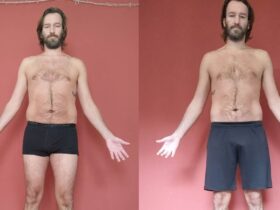Have you heard of zone 2 training? What happens to your body when you do zone 2 cardio training for 3 months? What changes? A guy did exactly that and tested his body before and after to see the differences and results.
Zone 2 training, also known as aerobic base training, is a method of exercise that focuses on training within a specific heart rate zone to improve aerobic fitness. It involves performing cardiovascular activities at a moderate intensity level that keeps your heart rate within a specific range.
The heart rate zone associated with Zone 2 training typically falls between 60-70% of your maximum heart rate (MHR). This zone allows you to exercise at a pace where your body predominantly utilizes fat as a fuel source, promoting endurance and cardiovascular adaptations. Zone 2 cardio training focuses on aerobic development and is often associated with low-intensity steady-state (LISS) workouts.
Here are some key points about Zone 2 training and its benefits:
- Aerobic Development: Zone 2 training primarily targets the aerobic energy system. By exercising within this heart rate range, you enhance your body’s ability to efficiently utilize oxygen, improve cardiovascular endurance, and develop a strong aerobic base.
- Fat Burning: Training in Zone 2 encourages the utilization of fat as a primary energy source. This can be beneficial for individuals aiming to lose body fat or improve body composition.
- Recovery and Active Rest: Zone 2 workouts are considered less intense and lower impact on the body compared to higher-intensity training zones. They provide active recovery and act as a form of active rest between more intense training sessions, helping to prevent overtraining and promote recovery.
- Building Endurance: Zone 2 training promotes muscular and cardiovascular endurance. By training at a sustained moderate intensity, you can improve your ability to maintain effort over extended periods, such as during long-distance running, cycling, or other endurance activities.
- Efficient Use of Training Time: Zone 2 training allows for longer durations of exercise without excessive fatigue or stress on the body. This can be advantageous for individuals who want to maximize their training time while minimizing the risk of injury or burnout.
- Mental Focus and Relaxation: Training in Zone 2 can provide an opportunity for mental relaxation, allowing you to focus on your breathing, form, and overall well-being. It can be a meditative and stress-relieving form of exercise.
It’s important to determine your individual heart rate zones based on your maximum heart rate (MHR) and fitness level. Various methods, such as using heart rate monitors or performing field tests, can help you establish your specific Zone 2 heart rate range.
The person in question who did zone 2 cardio training for 3 months to see how much that would change his body was Shervin Shaik. He is a regular guy, living in New York, who likes to share some different life experiences and tests. Although a lot of his videos shared on his YouTube channel are related to gadgets, he also tries to be healthier and fitter – he also shares those stories too.
What Happens to Your Body When You Do Zone 2 Cardio Training for 3 Months?
After doing some tests, Shaik discovered he doesn’t really have a zone 2, or he hasn’t been training for zone 2 so he needed to find out how to train to get to zone 2 regularly. After looking online for Iñigo San Millán, considered the godfather of zone 2 for cyclists, he came up with the meaning of zone 2:
“Your zone 2 is when you are able to output the maximum amount of power, so you’re trying to run or cycle as fast as possible, while keeping your lactate between 1.7 to 1.9 millivolts,” Shaik said. This is technically when your body is burning the most amount of fat vs carbs.
How to Increase Your Metabolism
 Source: Andrea Piacquadio / Pexels
Source: Andrea Piacquadio / PexelsSo Shaik trained around 180-360 minutes of zone 2 cardio per week (3-6 hours) with each session being between 45-90 minutes. But, the first few weeks he did just 30 minutes of running per session to get in the mindset of running. He also changed his diet to eat fats or protein with any carbs that he consumed.
He used a smartwatch tracker to beep every time his heart rate would fall off from the zone he was aiming for aligned with a chest heart rate strap to be very accurate and update your heart rate as fast as possible.
Sadly, Shaik didn’t take much care of his body while doing zone 2 cardio training for 3 months. His diet deteriorated by not eating much whole foods, he didn’t stretch enough or warmed up, and he felt stiffness and even pain in his ankles and lower back.
The Only 8 Bodyweight Exercises You Need to Build Muscle Fast
After 3 months, his bodyweight and body fat percentage were around the same. His testosterone, cortisol, iron and triglycerides dropped. “That could also be due to the fact that I was not eating properly, and now that I was exercising even more, I was losing certain things.”
His heart rate changed over 3 months to maintain 142 beats per minute from a pace of 9:05 minutes/mile to 8:49 minutes per mile. That is 15 seconds faster that his body is now able to train while running. Add that for a marathon training, and you shaved off a few minutes already. If you are consistent for months with this kind of workout, and you get a great PR if you run a marathon.
8 Lessons Learned from My First Half-Marathon
See the video from Shaik below for his full experience of doing zone 2 cardio training for 3 months and what that did to his body.
Running for Beginners: A Guide to Building Confidence and Keeping Routine
How to Speed Up Weight Loss – 10 Things You Can Do Now to Accomplish That
The process of body recomposition (losing fat while gaining muscle) typically involves the following key components:
- Resistance Training: Engaging in regular strength training exercises helps stimulate muscle growth and development. It involves performing exercises using weights, resistance bands, or bodyweight to challenge and overload the muscles, leading to hypertrophy (muscle growth) over time.
- Caloric Balance: Body recomposition requires paying attention to calorie intake and expenditure. To lose body fat while gaining muscle, you generally need to maintain a slight caloric deficit (consuming fewer calories than you burn) while ensuring an adequate intake of nutrients to support muscle growth and recovery.
- Protein Intake: Sufficient protein consumption is crucial for muscle building and repair. A higher protein intake helps support muscle protein synthesis and can aid in preserving lean muscle mass during the fat-loss phase.
- Cardiovascular Exercise: Incorporating cardio exercises, such as running, cycling, or swimming, can help increase calorie expenditure and support overall fat loss. However, it’s important to balance cardiovascular exercise with resistance training to ensure muscle preservation and growth.
- Progressive Overload: To continue making progress during body recomposition, it’s essential to progressively increase the intensity, volume, or resistance of your workouts over time. This progressive overload principle challenges your muscles and stimulates further growth.

It’s important to note that body recomposition is a gradual process that requires consistency, patience, and individual adjustments based on your body’s response. It may not happen as quickly as solely focusing on fat loss or muscle gain, but it can lead to long-term changes in body composition, overall strength, and aesthetics. Consulting with a qualified fitness professional or nutritionist can provide personalized guidance to help you achieve your body recomposition goals safely and effectively.
The Only 5 Exercises You Need to Look Super Jacked
How To Make The Biggest Visual Change To Your Body Quickly
How Many Steps Should You Walk Every Day to Lose Fat?
The Best Full Body Workouts: Beginner, Intermediate & Advanced
Source link: https://www.boxrox.com/what-happens-to-your-body-when-you-do-zone-2-cardio-training-for-3-months/ by Robert Born at www.boxrox.com






